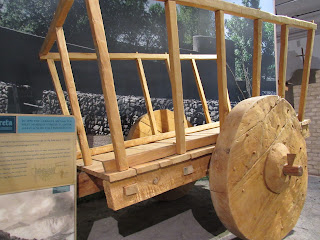We stopped in Alpine for a visit to the Museum of the Big Bend on the campus of Sul Ros University followed by a fabulous lunch at Reata Cowboy Cuisine.
 |
| A 416 lb bear killed in June 2009 in a collision with a vehicle. |
 |
It is a little hard to see but in the foreground
is a wing bone cast from a quetzalcoatlus
northropi found in Big Bend National Park.
In the background is a recreation of American
Indian painting found on a cave wall in BBNP |
The early native people in this we call Jumanos. Spanish explorer Cabeza de Vaca wrote of these people he met in the mid-1500s. "Their method of cooking is so novel and strange, let me describe it. Not having discovered pots, they fill a medium-sized gourd full of water and drop red-hot rocks in it with stick tongs until the water boils. Then for the whole while that whatever they put in to cook is cooking, they keep transferring more rocks from the fire and taking out the spent ones. They know which rocks take the heat best, and the water boils on and on."
 |
In 1895 two cowboys stumbled on a cache of 1700 arrowheads
on Mt. Livermore, the highest peak of the Davis Mountains.
Later studies determined they were an offering made by the
Livermore Phase people between 700 and 1300 AD. These
were nomadic hunter-gatherers and their religious beliefs "integrated
veneration of the mountain with shaministic practices." |
 |
La Carreta. These were the first wheeled carts in the new world.
First introduced in 1590 it became the major form of transportation
in the area for the next 300 years. |
 |
| Looks like this Spanish explorer, the first European in the Big Bend region, was not a very big guy. |
 |
Amazingly, Cabeza de Vaca made it to the Big Bend
area. He and 299 other men arrived in Florida in 1528. They
lose 50 to capture by natives. The remaining escape by raft.
After a storm, the last 80 are washed ashore at Galveston Island.
Only 3 survive to travel to the mainland where they are once again
taken captive by natives, but escape and make their way to the
Big Bend area. In 1536 Cabeza makes it to a Spanish outpost on
the Pacific Coast and then goes on to Mexico. |
 |
Mining operations here were most successful for Quicksilver
which is Mercury. |
 |
"The uniform and gear on display are typical of a
U.S. Cavalry soldier in 1874." |
 |
| "Hoss" went to school at Sul Ross University. |
 |
In the courtyard at Reata. Yep, that's James Dean on the wall.
The movie Giant was filmed in this area. |
 |
Reata's patio chairs have star shapes made by small holes
and the sun shines their patterns on the patio. |
ALL PHOTOS AND INFORMATION ARE COPYRIGHT PROTECTED. AS THE SOLE PROPERTY OF THE BLOGGER THEY MAY NOT BE REPRODUCED OR USED IN ANY WAY WITHOUT PERMISSION FROM THE BLOGGER.














Comments
Post a Comment